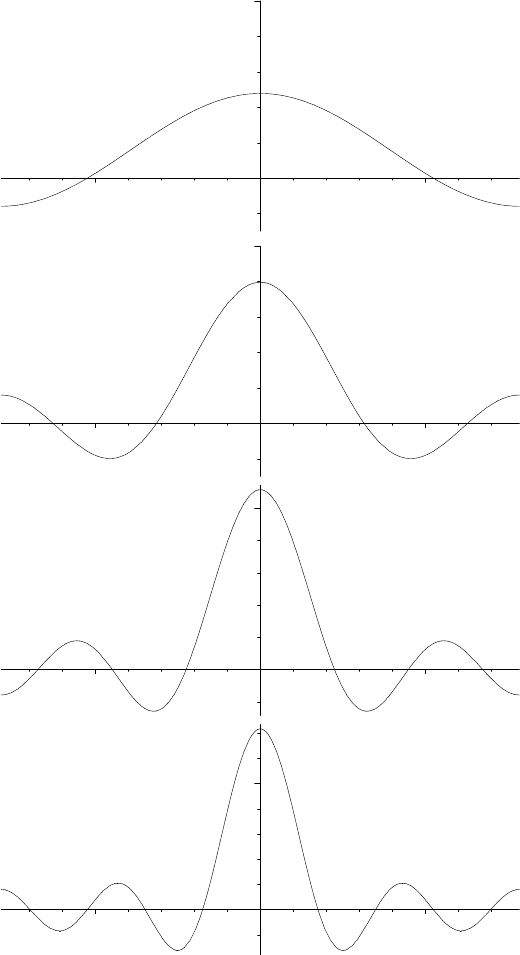Davidson K.R., Donsig A.P. Real Analysis with Real Applications
Подождите немного. Документ загружается.


14.3 The Riemann–Lebesgue Lemma 473
Let us compute the Fourier coefficients of f. Since f is odd, we need only
compute the sine terms. We integrate by parts three times.
B
n
=
1
π
Z
π
−π
(θ
3
− π
2
θ) sinnθ dθ
=
¡
θ
3
− π
2
θ
¢
π
−cosnθ
n
¯
¯
¯
¯
¯
π
−π
+
Z
π
−π
3θ
2
− π
2
nπ
cosnθ dθ
= 0 +
3θ
2
− π
2
n
2
π
sinnθ
¯
¯
¯
¯
¯
π
−π
−
Z
π
−π
6θ
n
2
π
sinnθ dθ
= 0 +
6θ
n
3
π
cosnθ
¯
¯
¯
¯
¯
π
−π
−
Z
π
−π
6
n
3
π
cosnθ dθ
=
6π
n
3
π
(−1)
n
−
−6π
n
3
π
(−1)
n
− 0
=
(−1)
n
12
n
3
.
In particular, we see that these coefficients satisfy
∞
X
n=1
¯
¯
¯
¯
(−1)
n
12
n
3
¯
¯
¯
¯
= 12
∞
X
n=1
1
n
3
< ∞.
Therefore, by the Weierstrass M-test, this series converges uniformly to a continu-
ous function. By Corollary 13.6.3, this series must converge to f uniformly on the
whole circle. Therefore,
θ
3
− π
2
θ =
∞
X
n=1
(−1)
n
12
n
3
sinnθ
for all θ ∈ [−π, π].
For example, plug in θ = π/2. Note that sin(2k + 1)π/2 = (−1)
k
and
sin(2k)π/2 = 0. So
³
π
2
´
3
− π
2
π
2
=
∞
X
k=0
(−1)
2k+1
12
(2k + 1)
3
(−1)
k
.
Solving, we find that
∞
X
k=0
(−1)
k
(2k + 1)
3
=
π
3
32
.
Now consider the derivative f
0
(θ) = 3θ
2
− π
2
. The Fourier series may be
differentiated term by term. We may apply Exercise 13.4.E since
∞
X
n=1
n|B
n
| =
∞
X
n=1
12
n
2
< ∞

474 Fourier Series and Approximation
to obtain another uniformly convergent series
3θ
2
− π
2
=
∞
X
n=1
(−1)
n
12
n
2
cosnθ for − π ≤ θ ≤ π.
Let us substitute θ =
π
2
here as well. Here cos
(2k+1)π
2
= 0 and cos
2kπ
2
= (−1)
k
.
So
−
π
2
4
=
∞
X
k=1
12
4k
2
(−1)
k
= −3
∞
X
k=1
(−1)
k−1
k
2
.
Therefore,
π
2
12
=
∞
X
k=1
(−1)
k−1
k
2
=
∞
X
k=1
1
k
2
− 2
∞
X
k=1
1
(2k)
2
=
1
2
∞
X
k=1
1
k
2
.
So we again obtain Euler’s sum
∞
P
k=1
1
k
2
=
π
2
6
.
Now we have to work harder to enlarge the class of functions. An important
step in establishing convergence is the apparently modest goal of showing that at
least the Fourier coefficients converge to 0. This is clearly a necessary condition for
any kind of convergence. This was by no means clear in the 1850s when Riemann
did his fundamental work. In fact, he introduced the modern notion of integral,
which we studied in Chapter 6, in order to address the question of convergence of
Fourier series.
14.3.3. THE RIEMANN–LEBESGUE LEMMA.
If f is piecewise continuous on [a, b] and τ ∈ R, then
lim
n→∞
Z
b
a
f(x) sin(nx + τ) dx = 0.
PROOF. The assumption that f is piecewise continuous is much stronger than is
really necessary. The result is true for all absolutely integrable functions. However,
the proof is more difficult.
We may assume that b − a ≤ π. For otherwise, we just chop the interval
[a, b] into pieces of length at most π and prove the lemma on each piece separately.
Translation by a multiple of π does not affect anything except possibly the sign of
the integral. So we may assume that [a, b] is contained in [−π, π]. Now extend the
definition of f to all of [−π, π] by setting f(x) = 0 outside of [a, b]. This is still
piecewise continuous, and the integrals are unchanged.

14.3 The Riemann–Lebesgue Lemma 475
We use the fact established in the last section that
A
2
0
+
1
2
∞
X
n=1
A
2
n
+ B
2
n
= kf k
2
2
< ∞.
Since the terms of a convergent series must tend to 0, we have
lim
n→∞
A
2
n
+ B
2
n
= 0.
So we compute
¯
¯
¯
¯
Z
π
−π
f(x) sin(nx + τ) dx
¯
¯
¯
¯
=
¯
¯
¯
¯
Z
π
−π
f(x) cosnx sinτ + sinnx cosτ dx
¯
¯
¯
¯
=
¯
¯
A
n
sinτ + B
n
cosτ
¯
¯
≤
q
A
2
n
+ B
2
n
.
The last estimate (which is included only for elegance) used the Cauchy–Schwarz
inequality. This establishes the desired limit. ¥
14.3.4. COROLLARY. If f is a piecewise continuous 2π-periodic function with
Fourier series
f ∼ A
0
+
∞
X
n=1
A
n
cosnθ + B
n
sinnθ,
then lim
n→∞
A
n
= lim
n→∞
B
n
= 0.
PROOF. Take the definitions of A
n
and B
n
and apply the Riemann–Lebesgue
Lemma for the interval [−π, π] and displacements τ = π/2 and τ = 0, respec-
tively. ¥
Exercises for Section 14.3
A. (a) Let 0 < a ≤ π. Compute the Fourier series for f(θ) = max{a − |θ|, 0}.
(b) Show that this series converges uniformly to f . Evaluate f(0) in two ways.
(c) Rearrange the series obtained in (b) to evaluate
P
n≥1
cosna
n
2
.
B. (a) Find the Fourier series for f(θ) =
(
sinθ if 0 ≤ θ ≤ π
0 if − π ≤ θ ≤ 0
.
(b) Evaluate
P
n≥1
(−1)
n
4n
2
− 1
.
C. Let f(x) = sin
1
x
for 0 < |x| ≤ π and f(0) = 0. This is not piecewise continuous.
Show that f is the limit of a sequence of continuous functions in the L
2
norm. Hence
show that the Fourier coefficients of f tend to 0.
D. Suppose that f is an absolutely integrable function for which there is a sequence of
continuous functions g
n
so that lim
n→∞
kf − g
n
k
1
= 0. Prove the Riemann–Lebesgue
Lemma for f.

476 Fourier Series and Approximation
E. Let f be a monotone function on [−π, π]. Prove that the Fourier coefficients satisfy
max{|A
n
|, |B
n
|} ≤
2M
nπ
, where M = |f(π) − f(−π)|.
HINT: Express B
n
as the sum of integrals over intervals on which sinnθ has constant
sign, and combine into a single integral.
F. Consider the DE y
00
+ 4y = g, where g is an odd C
2
function with Fourier series
P
n≥1
B
n
sinnx.
(a) If B
2
= 0, find the Fourier series of the solution.
(b) Verify that this series and its second derivative converge uniformly and thus provide
a solution.
(c) Show that y = −
1
4
x cos2x is the solution for g(x) = sin2x.
G. Let g be an odd function such that g(θ) ≥ 0 on [0, π].
(a) Show by induction that |sinnθ| < n sinθ on (0, π).
(b) Prove that the Fourier coefficients satisfy |B
n
| < nB
1
.
(c) Show by a series of examples that the previous inequality cannot be improved in
general.
H. (a) Show that for any a < b and any real values of α
n
, n ≥ 1,
liminf
n→∞
Z
b
a
|cos(nx + α
n
)|dx ≥
b − a
2
.
HINT: |cos(nx + α
n
)| ≥ cos
2
(nx + α
n
). Express this square in terms of cos 2nx
and sin2nx.
(b) Show that if r
n
are positive numbers such that
∞
P
n=1
r
n
|cos(nx + α
n
)| ≤ C for all
a ≤ x ≤ b, then
∞
P
n=1
r
n
< ∞.
I. Prove the Riemann–Lebesgue Lemma for absolutely integrable functions.
HINT: approximate the function by a step function in the L
1
norm.
14.4. Pointwise Convergence of Fourier Series
In order to establish a more delicate convergence theorem, a better method is
needed for computing the partial sums of the Fourier series. It turns out that there is
an integral formula using the Dirichlet kernel, which we define in a moment. This
new kernel is not nearly as nicely behaved as the Poisson kernel. Nevertheless,
it provides a better method for achieving good estimates than crudely estimating
individual terms.
14.4.1. DEFINITION. The sequence of functions D
n
given by
D
n
(t) =
2n + 1
2π
if t = 2πm, m ∈ Z
sin(n +
1
2
)t
2π sint/2
if t 6= 2πm,

14.4 Pointwise Convergence of Fourier Series 477
for n = 1, 2, . . . is called the Dirichlet kernel.
To see that D
n
is continuous at zero, compute
lim
t→0
D
n
(t) = lim
t→0
sin(n +
1
2
)t
t
t
2π sint/2
=
n +
1
2
2π/2
=
2n + 1
2π
.
The following theorem connects D
n
to Fourier series.
14.4.2. THEOREM. Let f be a piecewise continuous and 2π-periodic function.
Then
S
n
f(x) =
Z
π
−π
f(x + t)D
n
(t) dt.
PROOF. If we substitute the formulae for A
k
and B
k
into the definition of S
n
f,
then we obtain
S
n
f(x) = A
0
+
n
X
k=1
A
k
coskx + B
k
sinkx
=
1
2π
Z
π
−π
f(t) dt +
n
X
k=1
1
π
Z
π
−π
f(t) coskt dt coskx+
+
n
X
k=1
1
π
Z
π
−π
f(t) sinkt dt sinkx
=
1
2π
Z
π
−π
f(t)
³
1 + 2
n
X
k=1
coskt coskx + sinkt sinkx
´
dt
=
1
2π
Z
π
−π
f(t)
³
1 + 2
n
X
k=1
cosk(t − x)
´
dt
using the identity cos(A − B) = cosA cosB + sinA sin B. Then, substituting
u = t − x and using the 2π-periodicity of f, we have
=
Z
π
−π
f(x + u)
³
1
2π
+
1
π
n
X
k=1
cosku
´
du.
So to complete the proof, it is enough to prove the trig identity
1
2π
³
1 + 2
n
X
k=1
cosku
´
=
sin(n +
1
2
)u
2π sin(u/2)
= D
n
(u).
This identity may be computed by using complex exponentials as we did in
Lemma 13.10.4. Here we give a strictly real variable argument using the trig iden-
tity 2 sin A cos B = sin(A + B) − sin(A − B). We set up a telescoping sum, as

478 Fourier Series and Approximation
follows:
sin
u
2
³
1 + 2
n
X
k=1
cosku
´
= sin
u
2
+
n
X
k=1
2sin
u
2
cosku
= sin
u
2
+
n
X
k=1
¡
sin(k +
1
2
)u − sin(k −
1
2
)u
¢
= sin(n +
1
2
)u
= 2π sin
u
2
Ã
sin(n +
1
2
)u
2π sinu/2
!
provided u 6= 0. If u = 0, then we have
1
2π
Ã
1 + 2
n
X
k=1
cos0
!
=
2n + 1
2π
= D
n
(0),
and so the trig identity holds for all u. ¥
We collect here various properties of the functions D
n
that we will need later.
What makes the Dirichlet kernel significantly inferior to the Poisson kernel is that
the Dirichlet kernel is not positive. Indeed, the following properties (2) and (3)
together show that significant cancellation must occur in (2). Compare Figure 14.2
with Figure 13.2.
14.4.3. PROPERTIES OF THE DIRICHLET KERNEL.
The Dirichlet kernel D
n
satisfies the following properties:
(1) For each n, D
n
is a continuous, 2π-periodic, even function.
(2)
Z
π
−π
D
n
(t) dt = 1.
(3) For each n, .28 + .4logn ≤
Z
π
−π
|D
n
| ≤ 2 + log n
PROOF. By periodicity, it suffices to show D
n
is continuous at 0. Continuity at
0 follows from the limit computed just after the definition. The identity D
n
(t) =
1
2π
¡
1 + 2
n
P
k=1
coskt
¢
shows that D
n
is even and 2π-periodic.
If f(θ) = 1 for all θ, then the Fourier series of f is just f ∼ 1. Therefore,
S
n
f = 1 for all n ≥ 1. Using the integral formula of Theorem 14.4.2, we have
1 =
Z
π
−π
1D
n
(t) dt,
which proves (2).

14.4 Pointwise Convergence of Fourier Series 479
0
1
–2 2
0
1
–2 2
1
–2 2
0
1
–2 2
FIGURE 14.2. The graphs of D
1
, D
2
, D
3
, and D
4
.

480 Fourier Series and Approximation
The reader can check that
Z
π
−π
|D
1
(t)|dt =
Z
π
−π
|1 + 2 cos t|
2π
dt < 1.5. To
provide the upper bound on
R
|D
n
| for n ≥ 2, we first observe that
Z
π
−π
|D
n
(t)|dt = 2
Z
π
0
|D
n
(t)|dt =
Z
1/n
0
2|D
n
(t)|dt +
Z
π
1/n
¯
¯
¯
¯
sin(n +
1
2
)t
π sint/2
¯
¯
¯
¯
dt.
The first integral is estimated for n ≥ 2 as
Z
1/n
0
2|D
n
(t)|dt =
1
π
Z
1/n
0
¯
¯
¯
1 + 2
n
X
k=1
coskt
¯
¯
¯
dt
≤
1
π
1
n
(1 + 2n) ≤
2.5
π
< 0.8.
For the second integral, we use the inequalities π sin(t/2) ≥ t for t ≥ 0 and
|sin(n +
1
2
)t| ≤ 1 to obtain
Z
π
1/n
¯
¯
¯
¯
sin(n + 1/2)t
π sint/2
¯
¯
¯
¯
dt ≤
Z
π
1/n
1
t
dt = log π − log
1
n
< 1.2 + log n.
Combining these two integrals, we have
Z
π
−π
|D
n
(t)|dt ≤ 2 + logn.
For the lower bound, first note that
Z
(k+1)π/(2n+1)
kπ/(2n+1)
|sin(n + 1/2)t|dt =
Z
π/(2n+1)
0
sin(n + 1/2)t dt
=
2
2n + 1
Z
π/2
0
sint dt =
2
2n + 1
.
Now use the fact that sint ≤ t for t ≥ 0 to obtain
Z
π
−π
|D
n
(t)|dt = 2
Z
π
0
¯
¯
¯
¯
sin(n + 1/2)t
2π sint/2
¯
¯
¯
¯
dt ≥ 2
Z
π
0
¯
¯
¯
¯
¯
sin(n +
1
2
)t
πt
¯
¯
¯
¯
¯
dt
= 2
2n
X
k=0
Z
(k+1)π/(2n+1)
kπ/(2n+1)
|sin(n + 1/2)t|
πt
dt
≥ 2
2n
X
k=0
2n + 1
(k + 1)π
2
Z
(k+1)π/(2n+1)
kπ/(2n+1)
|sin(n + 1/2)t|dt
≥ 2
2n
X
k=0
2n + 1
(k + 1)π
2
2
2n + 1
=
4
π
2
2n
X
k=0
1
k + 1
.

14.4 Pointwise Convergence of Fourier Series 481
The integral test shows that
2n
P
k=0
(k + 1)
−1
≥ log(2n + 2), so
Z
π
−π
|D
n
(t)|dt ≥
4
π
2
(log2 + log(n + 1))
> .28 + .4 log n.
¥
This integral formula will now be used to establish convergence for reasonably
nice functions. The argument has some similarity to the Poisson Theorem, but
property (3) of the previous proposition forces us to be somewhat circumspect. At
a certain point, we will need to combine a Lipschitz condition with the Riemann–
Lebesgue Lemma to obtain the desired estimate.
14.4.4. DEFINITION. A function f is piecewise Lipschitz if f is piecewise
continuous, and there is a constant L so that f is has Lipschitz constant at most L
on each interval of continuity.
A function f is piecewise C
1
on [a, b] if f is differentiable except at finitely
many points, and f
0
is piecewise continuous.
For example, the Heaviside function H from Example 5.2.2 is piecewise C
1
.
Another example is f(x) = x −bxc, where bxc indicates the largest integer n ≤ x.
The cubic function f in Example 14.3.2 is piecewise C
2
and f
0
is piecewise C
1
.
Being piecewise C
1
implies piecewise Lipschitz with constant L = kf
0
k
∞
. In-
deed, observe that f
0
is bounded on each (closed) interval on which it is continuous
because of the Extreme Value Theorem (Theorem 5.4.4); and hence it is bounded
on [−π, π]. On any interval of continuity for f
0
, the Mean Value Theorem shows
that
|f(x) − f(y)| ≤ kf
0
k
∞
|x − y|.
These estimates can then be spliced together when the function is continuous on an
interval even if the derivative is not continuous.
For an example of a Lipschitz function that is not C
1
, consider f (x) = x
2
sin
1
x
for x 6= 0 and f (0) = 0. The derivative is defined everywhere:
f
0
(x) =
(
2x sin
1
x
− cos
1
x
for x 6= 0
0 for x = 0.
This is bounded by 3 on all of R, so the Mean Value Theorem argument is valid.
However, f
0
has a nasty discontinuity at the origin. So f
0
is not piecewise continu-
ous.
Dirichlet proved a crucial special case of this result in 1829. In his treatise, he
introduced the notion of a function which is in use today. Prior to that period, a
function was typically assumed to be given by a single analytic formula.

482 Fourier Series and Approximation
14.4.5. THE DIRICHLET–JORDAN THEOREM.
Suppose that a function f on R is 2π-periodic and piecewise Lipschitz. If f is
continuous at θ, then
lim
n→∞
S
n
f(θ) = f(θ).
If f has a jump discontinuity at θ, then
lim
n→∞
S
n
f(θ) =
f(θ
+
) + f(θ
−
)
2
.
PROOF. By Theorem 14.4.3 (2),
f(θ
+
) = f (θ
+
)
Z
π
−π
D
n
(t) dt = 2
Z
π
0
f(θ
+
)D
n
(t) dt
and a similar equality holds for f(θ
−
). Using Theorem 14.4.2,
S
n
f(θ) =
Z
π
−π
f(θ − t)D
n
(t) dt
=
Z
π
0
¡
f(θ + t) + f (θ − t)
¢
D
n
(t) dt.
Using this formula for S
n
f(θ) with the previous two equalities gives
S
n
f(θ) −
f(θ
+
) + f(θ
−
)
2
=
=
Z
π
0
¡
f(θ + t) + f (θ − t)
¢
D
n
(t) dt −
Z
π
0
¡
f(θ
+
) + f(θ
−
)
¢
D
n
(t) dt
=
Z
π
0
¡
f(θ + t) − f (θ
+
)
¢
D
n
(t) dt +
Z
π
0
¡
f(θ − t) − f (θ
−
)
¢
D
n
(t) dt.
We now consider these two integrals separately. First we prove that
lim
n→∞
Z
π
0
¡
f(θ + t) − f (θ
+
)
¢
D
n
(t) dt = 0.
An entirely similar argument will show the second integral also goes to zero as n
goes to infinity. Combining these two results proves the theorem.
Let L be the Lipschitz constant for f, and let ε > 0 be given. Choose a positive
δ < ε/L that is so small that f is continuous on [θ, θ + δ]. Hence
|f(θ + t) − f (θ
+
)| < Lt for all θ + t ∈ [θ, θ + δ].
Since |sin(t/2)| ≥ |t|/π for all t in [−π, π], it follows that
|D
n
(t)| =
¯
¯
¯
¯
sin(n +
1
2
)t
2π sint/2
¯
¯
¯
¯
≤
1
2|t|
− π ≤ t ≤ π.
Therefore,
¯
¯
¯
¯
Z
δ
0
¡
f(θ + t) − f (θ
+
)
¢
D
n
(t) dt
¯
¯
¯
¯
≤
Z
δ
0
Lt
1
2t
dt ≤
Lδ
2
<
ε
2
.
